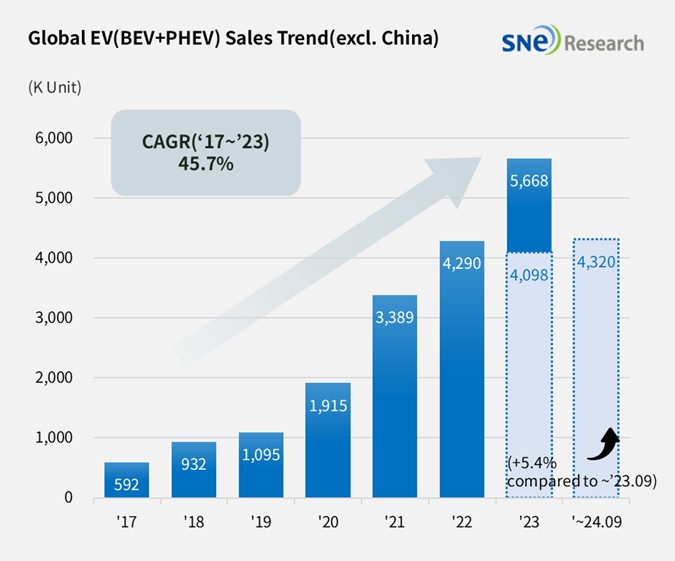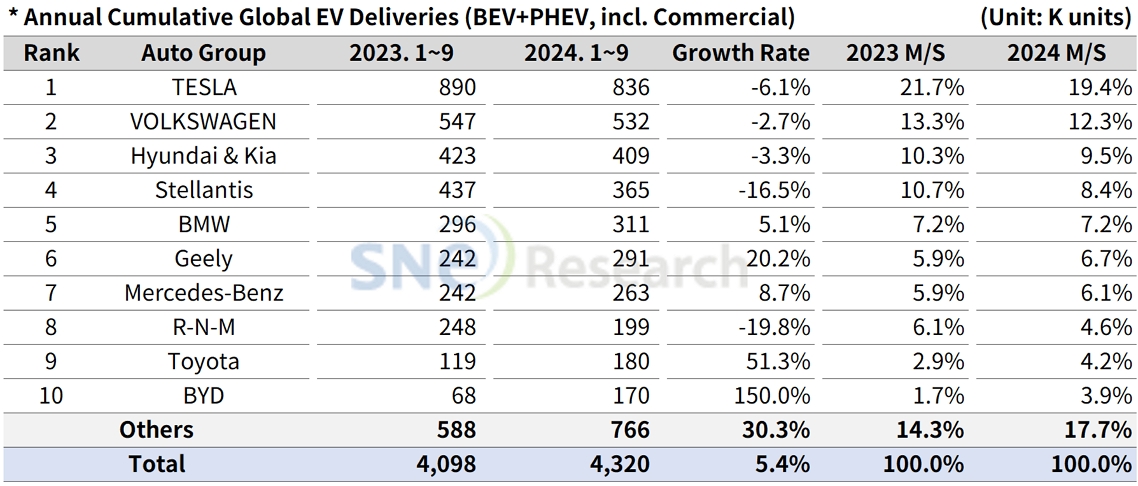From Jan to Sept 2024, Non-China Global[1] Electric Vehicle Deliveries[2] Recorded About 4.32 Mil Units, a 5.4% YoY Growth
- Tesla ranked No. 1 in non-China EV market; EV OEMs posted a degrowth again.
From Jan to Sept 2024, the total number of electric
vehicles registered in countries around the world except China was approx. 4.32 million units, a 5.4% YoY increase.

(Source: Global EV & Battery Monthly Tracker – Oct 2024, SNE Research)
If we look at the number of electric vehicles sold in the world except the China market from Jan to Sept 2024, despite recording a degrowth, Tesla stayed No. 1 on the list. Tesla recorded a 6.1% YoY degrowth as the sales of Model Model 3/Y, which take up about 95% of Tesla’s entire sales, have decreased. Tesla saw a 12.3% YoY decrease in Europe and a 5.9% YoY decrease in sales in North America. Although its EV sales recorded a degrowth, Tesla’s sales profit in Q3 2024 was approx. US$ 2.7 billion, a 54% increase compared to last year. It seemed that Tesla was able to earn high net profit in Q3 2024 thanks to carbon credit sales and its effort to reduce the production cost.
The Volkswagen Group, where Audi, Porsche, and Skoda belong to, posted a 2.7% YoY degrowth and ranked 2nd. Although Audi’s Q4/8 e-tron and PHEV models showed a steady increase in sales, sales of VW’s main models, ID.3/4/5, have been sluggish. This seemed to be caused by a continuing slowdown in EV demand in the European market.
The 3rd place was taken by Hyundai Motor Group, selling about 409k units and posting a 3.3% YoY degrowth. Sales of IONIQ 5 and EV 6 experienced a slowdown compared to the same period of last year, but the global sales of EV 9 have been expanding. In particular, Hyundai Motor Group outperformed Stellantis, Ford, and GM in terms of EV deliveries in the North American market. As sales of EV 3 and Casper Electric, to which LG Energy Solution’s battery is installed, have been rapidly expanding since their launch, the Korean auto group is expected to turn to an upward trajectory around the end of this year, mainly focusing on the entry-level EV market.

(Source: Global EV & Battery Monthly Tracker – Oct 2024, SNE Research)
By region, the European market, with a 1.4% degrowth, saw a gradual slowdown in growth, but still it accounted for more than half of the non-China market. In the European market, Geely(25.5%), Mercedes-Benz(12.0%), and BMW(9.9%) all recorded a growth compared to the same period of last year. On the other hand, Tesla, Stellantis, and Renault exhibited a degrowth in sales, showing that the European region has hit a speed bump in growth.
North America posted an 8.6% YoY growth. Despite the implementation of IRA, the slowdown in EV demand has not been solved yet. Instead, demand for hybrid vehicles has been skyrocketing, leading OEMs to focus more on the development of hybrid models. Recently, many OEMs, including Hyundai Motor Group, announced to develop EREV(Extended-Range Electric Vehicle)s to actively address the demand for hybrid vehicles.
In Asia (excl. China), OEMs like BYD, SAIC, and VinFast have been actively working on overseas market entrance, and thanks to their sales expansion, the growth in the region posted a 15.4% YoY growth. In particular, based on its success in Vietnam, VinFast has been expanding its target markets to countries neighboring Vietnam such as the Philippines and Indonesia. In North America, VinFast is currently working on launching various models and local production to reinforce its competitiveness in the region.

(Source: Global EV & Battery Monthly Tracker – Oct 2024, SNE Research)
At the moment, the EV market has been weathering through the chasm phase, and as an alternative to overcome the chasm, hybrid vehicles have been rising as an important instrument. Due to concerns about high initial cost of electric vehicles, shortage of charging infrastructure, and battery safety related to fire incidents, consumers have been showing an increasing interest in hybrid vehicles. The existing OEMs are also currently focusing on the development of hybrid models in consideration of their future profits and somewhat-alleviated regulations on ICE vehicles.
[2] Based on electric vehicles (BEV+PHEV) delivered to customers or registered during the relevant period.

